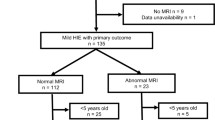Abstract
Objective:
To evaluate an electroencephalography (EEG)-based index, the Cerebral Health Index in babies (CHI/b), for identification of neonates with high Sarnat scores and abnormal EEG as markers of hypoxic ischemic encephalopathy (HIE) after perinatal asphyxia.
Study Design:
This is a retrospective study using 30 min of EEG data collected from 20 term neonates with HIE and 20 neurologically normal neonates. The HIE diagnosis was made on clinical grounds based on history and examination findings. The maximum-modified clinical Sarnat score was used to grade HIE severity within 72 h of life. All neonates underwent 2-channel bedside EEG monitoring. A trained electroencephalographer blinded to clinical data visually classified each EEG as normal, mild or severely abnormal. The CHI/b was trained using data from Channel 1 and tested on Channel 2.
Result:
The CHI/b distinguished among HIE and controls (P<0.02) and among the three visually interpreted EEG categories (P<0.0002). It showed a sensitivity of 82.4% and specificity of 100% in detecting high grades of neonatal encephalopathy (Sarnat 2 and 3), with an area under the receiver operator characteristic (ROC) curve of 0.912. CHI/b also identified differences between normal vs mildly abnormal (P<0.005), mild vs severely abnormal (P<0.01) and normal vs severe (P<0.002) EEG groups. An ROC curve analysis showed that the optimal ability of CHI/b to discriminate poor outcome was 89.7% (sensitivity: 87.5%; specificity: 82.4%).
Conclusion:
The CHI/b identified neonates with high Sarnat scores and abnormal EEG. These results support its potential as an objective indicator of neurological injury in infants with HIE.
This is a preview of subscription content, access via your institution
Access options
Subscribe to this journal
Receive 12 print issues and online access
$259.00 per year
only $21.58 per issue
Buy this article
- Purchase on Springer Link
- Instant access to full article PDF
Prices may be subject to local taxes which are calculated during checkout




Similar content being viewed by others
References
Seagal S . Perinatal Hypoxia-Asphyxia, Neonatology on the Web 1995. Cedars Sinai Medical Center: Los Angeles CA.
Van Lieshout HB, Jacobs JWFM, Rotteveel JJ, Geven W . The prognostic value of the EEG in asphyxiated newborns. Acto Neurol Scand 1995; 91 (3): 203–207.
Torfs C, Van den Berg BJ, Oeschsli FW, Cummins S . Prenatal and perinatal factors in the etiology of cerebral palsy. J Pediatr 1990; 116: 615–619.
Smith J, Wells L, Kodd K . The continuing fall in incidence of hypoxic-ischaemic encephalopathy in term infants. Br J Obstet Gynecol 2000; 107: 461–466.
Evans DJ, Levene MI . Anticonvulsants for preventing mortality and morbidity in full term newborns with perinatal asphyxia [systematic review]. Cochrane Database of Systematic Reviews 2001 Issue no. 3. Article no.: CD001240. 3.
Battin MR, Dezoete JA, Gunn TR, Gluckman PD, Gunn AJ . Neurodevelopmental outcome of infants treated with head cooling and mild hypothermia after perinatal asphyxia. Pediatrics 2001; 107 (3): 480–484.
Woodgate PG, Davies MW . Permissive hypercapnea for the prevention of morbidity and mortality in mechanically ventilated newborn infants [systematic review]. Cochrane Database of Systematic Reviews 2001 Issue no. 3. Article no.: CD002061. 3.
Kecskes Z, Davies MW . Rapid correction of early metabolic acidosis versus placebo, no intervention or slow correction in LBW infants [protocol]. Cochrane Database of Systematic Reviews 2002, Issue no. 1. Article no.: CD002976. 3.
Suresh GK, Davis JM, Soll RF . Superoxide dismutase for preventing chronic lung disease in mechanically ventilated preterm infants [systematic review]. Cochrane Database of Systematic Reviews 2001 Issue no. 1. Article no.: CD001968. 3.
Guan J, Bennet L, George S, Wu D, Waldvogel HJ, Gluckman PD et al Insulin-like growth factor-I reduces protischemic white matter injury in fetal sheep. J Cereb Blood Flow Metab 2001; 21 (5): 493–502.
Gunn AJ . Cerebral hypothermia for prevention of brain injury following perinatal asphyxia. Curr Opin Pediatr 2000; 12 (2): 111–115.
Gunn AJ, Gluckman PD, Gunn TR . Selective head cooling in newborn infants after perinatal asphyxia: a safety study. Pediatrics 1998; 102 (4 pt 1): 885–892.
Groenendaal F, de Vries LS . Selection of babies for intervention after birth asphyxia. Semin Neonatol 2000; 5 (1): 17–32.
Al Naqeeb N, Edwards AD, Cowan FM, Azzopardi D . Assessment of neonatal encephalopathy by amplitude-integrated encephalopathy. Pediatrics 1999; 103 (6): 1263–1271.
Toet MC, Hellstrom-Westas L, Groenendaal FP, Devries L . Amplitude Integrated EEG 3 and 6 hours after birth in full term neonates with hypoxic-ischaemic encephalopathy. Arch Dis Child Fetal Neonatal Ed 1999; 81 (1): F19–F23.
Lukaskova JZ, Kokstein Z . Cerebral function monitoring in neonates with perinatal asphyxia—preliminary results. Neuro Endocrinol Lett 2008; 29 (4): 522–528.
Liu DL, Shao XL, Wang JM . Amplitude integrated enecephalopathic monitoring in early diagnosis and neurological outcome prediction of term infants with hypoxic ischemic encephalopathy. Zhnghua Er Ke Za Zi 2007; 45 (1): 20–23.
Toet MC, Van Der Meij W, De Vries LS, Uiterwaal CS, Van Huffelen KC . Comparison between simultaneously recorded amplitude integrated electroencephalogram (cerebral function monitor) and standard electroencephalogram in neonates. Pediatrics 2002; 109 (5): 772–779.
Acknowledgements
The project described was supported by Award Number R44HD042872 from the Eunice Kennedy Shriver National Institute Of Child Health & Human Development. The content is solely the responsibility of the authors and does not necessarily represent the official views of the Eunice Kennedy Shriver National Institute Of Child Health & Human Development or the National Institutes of Health. BrainZ Instruments did not provide any financial support to this study.
Author information
Authors and Affiliations
Corresponding author
Rights and permissions
About this article
Cite this article
Hathi, M., Sherman, D., Inder, T. et al. Quantitative EEG in babies at risk for hypoxic ischemic encephalopathy after perinatal asphyxia. J Perinatol 30, 122–126 (2010). https://doi.org/10.1038/jp.2009.130
Received:
Revised:
Accepted:
Published:
Issue Date:
DOI: https://doi.org/10.1038/jp.2009.130
Keywords
This article is cited by
-
An Automated System for Grading EEG Abnormality in Term Neonates with Hypoxic-Ischaemic Encephalopathy
Annals of Biomedical Engineering (2013)



